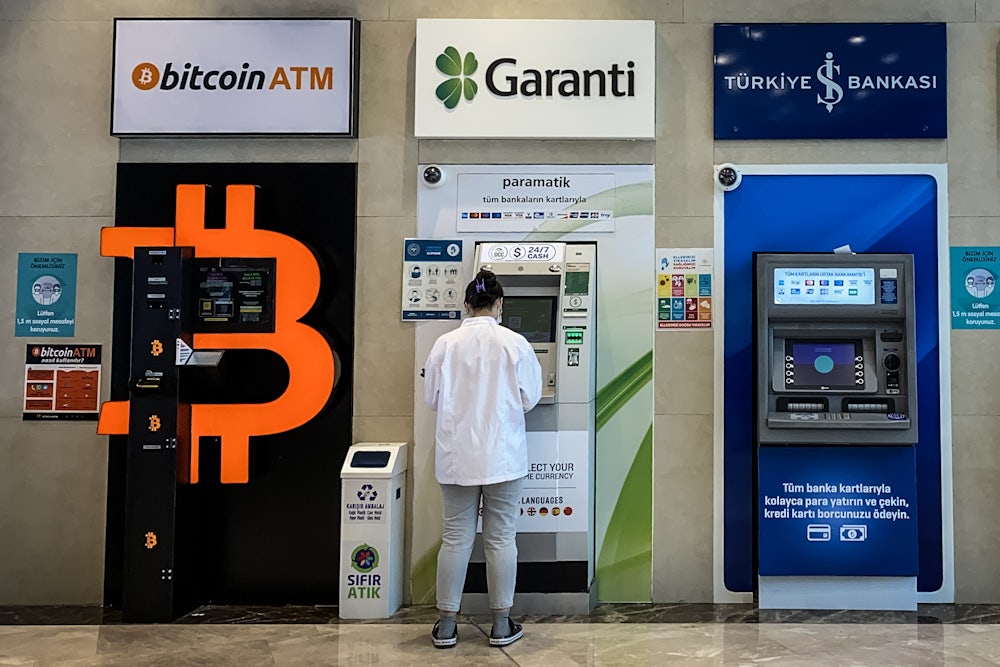It was almost cryptocurrency’s Black Wednesday. In the space of a few hours, Bitcoin’s price fell by up to 30 percent, from about $43,000 to around $31,000, before rebounding. As of now, it’s far from its all-time high of more than $63,000, reached just last month, and has lost about 27 percent of its value in the last week. The rest of the top cryptocurrencies are a sea of red; at one point, about 20 percent of the entire market’s value had been wiped out, according to CoinMarketCap. Crypto-connected stocks like Tesla and MicroStrategy declined. The exchanges Coinbase, Kraken, and Gemini all had technical issues that hindered trading. Equal measures of fear and resolve spread through Twitter and other social media, as true believers separated themselves from panic sellers.
In a Clubhouse room called “Thought this was easy? Hodling Bitcoin ain’t easy,” about 1,400 people assembled Wednesday morning to hear their fellow coiners promise that everything was just fine. There was little dissent in the room—some hypothetical questions about how to answer common criticisms of Bitcoin were shouted down as so much more “FUD,” or fear, uncertainty, and doubt. There was plenty of searching for coping mechanisms.
We’ll get through this. “Inflation is the real problem,” someone said. Go to sleep, go outside, go exercise—just don’t follow the swings of the market. “I’m not going to be concerned about Bitcoin,” he said. “It’s going to be fine.”
Another man talked about his cold storage wallet—often, a hard drive that contains an access key for one’s Bitcoin—and said it was buried under concrete, like in a John Wick movie. He didn’t want to even think about selling his Bitcoin.
No matter how you parse it, now is a rough time to be a cryptocurrency investor. After reaching its epic April high, Bitcoin’s price has been sliding for a month, losing about 27 percent of its value in the last week. While Bitcoin partisans claim that they are holding for the long term and these are merely momentary blips, Bitcoin’s recent profound volatility signals the essential vulnerabilities of cryptocurrencies: namely, they are unstable assets built on speculation and market manipulation—including ad hoc social media campaigns designed to keep skittish investors from engaging in a mass selloff that would further tank prices. Requiring constant public urging from prominent influencers to keep retail investors engaged, cryptocurrencies may never be ready for the kind of widespread adoption their fans believe is inevitable.
But don’t tell that to the incorrigible optimists—or however you’d like to describe them—of the Bitcoin community. Elon Musk may have turned against the preeminent cryptocurrency; Chinese regulation may imperil a significant portion of Bitcoin mining and trading; and Tether, a stablecoin that’s the most traded cryptocurrency by volume, faces a legal deadline in which it’s expected to provide evidence clarifying its rather opaque mix of asset reserves to the New York attorney general. Any one of these items could trigger market trouble, but the combined effects were, at least for one wild morning, immensely destabilizing.
For crypto believers, though, today was merely a “correction,” a market stress test. Some portfolios will survive, some won’t. Promoters of so-called altcoins or shitcoins (as most coins outside of the top few are called) may have little rhetorical ballast to support their positions—many traders would admit that they’re looking for quick gains, not investing for the long term, and that now they’re reaping the consequences of their decisions. But the same can’t be said of Bitcoin fanatics, who despite facing enormous losses over recent weeks, with volatility to match, have taken to expressing overwhelming confidence in their positions. “I’m not selling,” tweeted Michael Saylor, a tech executive who’s emerged as a top Bitcoin mandarin. He and others claim that they are HODLing: hoarding their Bitcoin for the long term. Anthony Pompliano, one of the most voluble Bitcoin influencers, complained that clogged exchanges made it difficult to buy more Bitcoin today. (Pompliano, who might politely be called the rise-and-grind hustle-king of Bitcoin, yesterday launched something called Bitcoin Pizza, a “Bitcoin-themed pizza service” that only accepts dollars.)
You see? Things are fine. Or at least this is what they’re telling one another.
Someone in Clubhouse on Wednesday morning railed against the “financial jihadis” of the mainstream financial system. They were the true problem. Others were baffled at people’s concern: “This is normal. This is entirely normal.” Bitcoin veterans had survived past major dips, most recently in 2017. Someone chimed in that “anybody could have predicted this happening.”
Now was the time to affirm one’s faith. The smart people—like Saylor, the MicroStrategy CEO who just yesterday announced a small-by-his-standards $10 million Bitcoin buy—were surely buying the dip. “This is a great place to buy. This is a great place to hold.”
No one disagreed. “The only thing that’s going to happen is that people are going to wish they held on,” someone said.
The attendant decline in “shitcoins”—many of the top 100 cryptocurrencies were down 20 percent or more—was irrelevant. “Bitcoin is the only true cryptocurrency.”
A confident male voice (they were almost all male) chimed in. Markets are dependent on two emotions, he said: “fear and greed.” Dispense with fear. Remember the feeling you had last month when Bitcoin was over $60k.
Someone talked about being publicly rejected by a girl when he was in school; that was worse than any Bitcoin loss.
It’s good to know all sides, another said. What is the biggest risk for Bitcoin? “Aliens or lizard people,” went the first answer.
There was a revivalist sensibility in the virtual air. Someone called Bitcoin “inevitable,” something released from Pandora’s box. One could imagine this feverish dialogue in a men’s group, a circle of people bonding through emotional confessions. “I am so grateful for this price level this morning,” another man said. “I have more Bitcoin than I did yesterday. If you can survive this, you can survive anything. Welcome to Bitcoin.”








